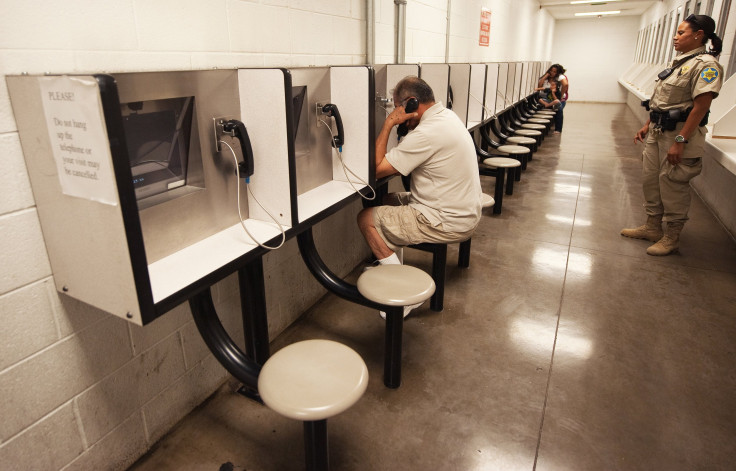How Prison Phone Calls Became A Tax On The Poor

On a recent sticky morning in a trailer park in Biloxi, Mississippi, Mary Jo Barnett switched on her 8-inch Samsung Galaxy tablet to speak with her 20-year-old daughter, Amber, who suffers from bipolar disorder and post-traumatic stress disorder (PTSD). Amber is currently locked up 490 miles away in the Marion County Jail in Ocala, Florida, and these video visits are her only lifeline to her family and the outside world.
Without communication, Mary Jo says she fears her daughter may suffer a mental breakdown or start a fight, which could lengthen her jail sentence. “Just getting to talk to her and interacting with her can make the difference in her mindset,” Mary Jo says.
Communication, however, is enormously expensive for Mary Jo, a 52-year-old grandmother who lives on $733 monthly disability checks. The video visitations cost $10 per 30-minute visit, or $19.99 per month. Phone calls, meanwhile, cost $3.98 for every 15 minutes, plus a $9.95 fee to load money into an account. Part of the reason the calls are so expensive is because a private company, Securus Technologies, has an exclusive contract to operate the phone and video visitation system in the jail. But an even larger reason the phone calls are so expensive is because the local sheriff’s office takes a large cut of the money, called a “commission.” Last year, Marion County received $549,804.52 in commissions from Securus, according to contracts and financial documents obtained by International Business Times through a records request.
Studies have consistently shown that communication with family members lowers the rates of inmate recidivism. But calls are often too expensive for lower-income people, which make up the vast majority of those who are incarcerated.
Mary Jo, who recently had to borrow money from Amber’s older sister to load money into her account, says she’s thankful she can even speak to her daughter at all. She has a tablet computer, which means she can sign up for the video visitations for $19.99 per month. But she says other inmates in the jail have it much worse. In fact, she says that her daughter will relay messages from inmates whose families can’t afford the calls at all.
“It’s mainly hard on her children. They can’t speak to their mother. Because I can’t afford it. I can only do like $20 per month. That’s all I can afford. That’s only three phone calls.”
Pretty much all of the messages, she says, are pleas from inmates to family members to place more money on the inmate’s commissary and phone accounts. But often, she says, the family member will just say they can’t afford it. “Some of them just say, ‘Hi, I love you,’” she says.
In this way, Mary Jo has met Omarah Zemorah, a 42-year-old resident of Ocala, Florida, and the mother of a 24-year-old inmate, Estrella King, who is pregnant with her fourth child. Zemorah, who makes $8 an hour as a cashier, says her daughter, who is locked up because she violated her parole, will sell her food to other inmates in order to get them to relay messages to her and her children. “I can’t afford to talk to her,” Zemorah says. “My daughter sells her trays [of food] inside the county to be able to call me... It’s mainly hard on her children. They can’t speak to their mother. Because I can’t afford it. I can only do like $20 per month. That’s all I can afford. That’s only three phone calls.”

Zemorah, who scrapes by on food stamps and by taking extra shifts at the Dollar General store in Ocala, has custody of five children — two of her own and three grandchildren — and will soon have custody of a sixth when her daughter gives birth. Zemorah says that her grandchildren, especially the older boy, are suffering without being able to speak with their mom.
Her grandson, she says, “was an honor roll student, and he never got in trouble.” But now, “he went down to Fs and [has] bad behavior ever since [his mom] went back to jail.”
Because she works so often, in-person visitations are impossible. So Zemorah waits for the calls from Mary Jo. Mary Jo, in turn, waits for the calls from Amber. Amber, meanwhile, says the high cost of communication is literally driving people behind the jail walls insane.
“There’s so much stress,” Amber told me recently. “People are heartbroken. People miss their kids. They can’t talk to them. People go crazy inside.”
In October, the Federal Communications Commission voted to cap the rates and fees companies were allowed to charge families and friends of inmates. Mignon Clyburn, an FCC commissioner who led the charge for reform, has called the prison phone industry the “most egregious case of market failure” she has seen in her career.
Theoretically, the new rules would make it more affordable for families to connect. However, there have been setbacks.
While new rules that would lower the cap on call rates were scheduled to become effective March 17, regulators have encountered pushback. Late last year, Securus and Global Tel*Link, another prison telecommunications provider, filed a lawsuit against the FCC to block the regulation. A stay was granted, delaying the implementation of the new rate cap. Then, several states led by Oklahoma, joined the companies and filed a joint lawsuit that challenged the FCC’s statutory authority. Oklahoma also claims that lower phone rates will cost its budget $3 million in commission payments.
Commissions, however, are part of the reason rates are so high. The FCC does not have plans to ban the practice. However, in court filings the regulatory body notes that it “strongly discourages” their use. Regardless of where the money goes, family members just want a more affordable way to keep in touch.

On recent video call, Mary Jo sat at her kitchen table and opened the blinds so her daughter could see the birds outside. They talked about everything from her nephew's recent track meet to a rather unpleasant sewage problem at the jail.
Later, Mary Jo told me that the smell of raw sewage is a trigger for her daughter’s PTSD, which started after Hurricane Katrina. Mary Jo says that in 2005, when Amber was eight, the storm washed away the family’s home. Amber “literally had to swim out of the house” and nearly drowned. Soon after, she says, Amber started getting nightmares when she slept and began acting out in school.
Mary Jo does her best to calm her daughter when they speak.
“No matter where they move you to, you're going to have issues,” Mary Jo said to Amber, who last year was convicted at age 18 of accessory charges to her then-boyfriend, a 39-year-old man who had stolen a car. “That's why they call it jail.”
“I know, mom,” Amber said.
“When you get home, I'll show you how to be a voice of change, so you can keep helping the ones in there.”
“Yeah. I wanna help people. I wanna help young people.”
“Obama is supposed to be doing more clemency. Letting people out.”
“For real?”
“Yeah, they got 25 people on that list.”
“I gotta get me on that list.”
The mother and daughter giggle.
A loudspeaker in the background announces that calls will be shutting down soon. They each say “I love you,” the call ends and Mary Jo switches off her phone.
Later, Mary Jo reviewed her phone bills at her kitchen table. She said she wishes she could talk to her daughter more often, to keep her daughter calm, but she just can’t afford it. “I think it’s an injustice,” she tells me. “I think they’re money hungry, money grubbers. I think it’s a real big injustice.”
So where does Mary Jo’s money actually go? According to the most recent county contract with Securus, obtained by IBT through a records request, Securus takes 60.5 percent of the call revenue and 20 percent of the video revenue and hands it back to Marion County’s sheriff's office.
In this manner, Marion County, where 20 percent of the population under the age of 18 lives below the poverty line, has made over half a million dollars in the last year alone. That money is deposited into what’s called an “inmate canteen fund,” which is used, according to Jeremiah Powell, a representative from the Marion County sheriff’s office, for the “benefit of the inmates.”
According to county records, the county uses the funds for a variety of purchases. While the county spends thousands on the inmate law library and subscriptions to the local paper for inmates, it also used inmate phone money to buy $10,000 worth of chickens, $3,340 on pigs (the country jail maintains a farm for inmates) and $28,800 on service repairs to the jails.
Inmate Fund at Marion County Jail
In America, “inmate welfare funds” are a pervasive source of funding for local jurisdictions. For years, cash-strapped sheriffs and law enforcement officials around the country have contracted with third-party vendors — including commissary vendors and even medical providers — to take a cut of the proceeds. The size of the fund will typically depend on the size of the county or state correctional facility and how many inmates are locked up.
As the name implies, these funds are intended for inmate mental health programs, indigent supplies and rehabilitation services. In other words, they’re typically not huge sources of funding, but they are intended to cover the “extras” that general taxpayers often don’t want to pay.
But over time, there’s been a broadening of how inmate welfare money has been spent. Inmate advocates, like Paul Wright of the Human Rights Defense Center, says these payments are nothing more than a form of “kickbacks” that artificially inflate prices for poor families and get spent with little to no oversight or auditing. “It's a total slush fund,” Wright says, noting several instances in which local agencies bought police cruisers and jail supplies. “A boondoggle of corruption.”
While the county spends thousands on the inmate law library and subscriptions to the local paper for inmates, it also used inmate phone money to buy $10,000 worth of chickens, $3,340 on pigs, and $28,800 on service repairs to the jails.
Justin Jones, Oklahoma’s former director of corrections, says that state prisons have strong regulations on how inmate welfare money is spent, but on the county level there’s little oversight.
“What you find across the country is that when you see diminishing returns either at the county or state level, you’ll see the broadening of definitions of how those funds can be spent,” Jones says.
He added, “This is just another piece of what we have evolved into as a country in the form of fines and fees and commissions for those that, in a previous decade, were funded by government sources.”
For phone providers, offering high commissions is a way to win business. In some states, commissions have reached 94 percent. “Part of the heritage of our business is that we calculate, bill and collect commissions and pay those to jails,” says Rick Smith, Securus’ chief executive, in promotional materials. In the last decade, the Dallas-based company, which contracts with 3,450 prisons and jails across the United States, says in its marketing materials that it has paid out $1.3 billion in such payments.
Wright, the inmate advocate, says it doesn’t actually even matter what the county is using the money for at all — they shouldn’t have the money in the first place. “If they decide Tasers are important, then they need to buy them with county money,” he says. “It’s a total perversion of democracy to turn the families of inmates into revenue streams.”
In Marion County, where Mary Jo’s daughter Amber is currently being held, phone bills aren’t the only source of financial strain. Anyone who is booked into the jail is required to pay an “Initial Subsistence Fee” of $22 and a “Medical Intake Fee” of $10. Inmates are also charged $3 per day for meals, sanitation and hygiene items, according to the Marion County inmate handbook.
One afternoon in March, Mary Jo spoke openly about being poor and not being able to keep in touch. “I don’t think she deserves special privileges or nothing, but they have a lot of people that have these mental illnesses and they aren’t getting the attention they need.”
Amber, her daughter, agrees that the calls keep her stable. “It’s like stress,” Amber says. “If I want to be able to talk to my parents, or my sister, it drives me crazy, like, ‘What’s going on with them? Are they OK? Are the bills getting paid?’ I can’t do nothing, but at least I could offer emotional support. I feel like I should be allowed to talk to my family at a reasonable price rate. But with outrageous price rates, it’s hard to do that.”
The country’s largest inmate welfare fund exists in Los Angeles, which oversees 18,000 inmates and generates about $24 million annually for the county’s inmate welfare fund, according to county records. In response to upcoming regulations, Los Angeles County Sheriff Jim McDonnell recently wrote to the FCC, noting that these “revenue contracts” provide relief for indigent inmates and offer a “crucial funding source that supports services like these and sorely needed rehabilitation programs.”
“It’s a total perversion of democracy to turn the families of inmates into revenue streams.”
IBT reviewed recent financial documents as well as a county audit of the Los Angeles County inmate welfare fund. The documents reveal that officials have been using the funds to purchase everything from security cameras to weapons to refrigeration equipment.
For instance, between 2011 and 2013 officials in the LA County jail division spent $553,983.15 on “Camera and Monitoring Improvements,” as well as $15,900.37 spent on “police equipment,” according to a review of those records. The police equipment included “Tasers, mannequin face shields, podium microphones, etc., for all jail facilities for training and containment in case of emergency incidents.”
Now that the FCC has begun capping phone rates, companies and local law enforcement officials are increasingly looking at video visits — which are unregulated — as a way to recoup lost revenue. “In many ways, sheriffs are looking at this as a way to capitalize on video visitation,” says Josh Gravens, the executive director of Organize Justice, a grassroots inmate advocacy group in Dallas. “We’ve seen this from correctional officers for decades. They’re willing to set people aside for profit, for the bottom line.”
In Marion County, Securus spent $955,940 to install 107 video visitation terminals at no cost to the taxpayers, according to the county contract. Omarah Zemorah, the mother of the pregnant inmate, said she’d like to make video visits, but even if she could afford the per-call fee, which she can’t, she doesn’t even own a computer. She says it’s literally a decision between putting food on the table and talking with her daughter.
“It hurts,” she says. When the children do get to talk with their mother, which happens three or four times per month, the children are elated. “They say they love her and they miss her and they can’t wait to see her,” Zemorah says.
“I have no help,” she says. “Nowhere.”
Zemorah says that it’s “awfully nice” of Mary Jo Barnett to relay messages to her from time to time.
For Mary Jo Barnett, who does not own a car and could not afford the travel to see her daughter in person, the video visitations offer a glimmer of promise of what the future of video visitations could hold for families.
On a recent call, Mary Jo and Amber spoke about her nephew’s upcoming track meet.
“I'm gonna try and bring my wheelchair and go to that one,” Mary Jo said.
“Have fun,” Amber says.
“When you get home, I'm gonna have you push me!”
“I ain't that strong.”
“Look at them arms. You’re strong enough to push me.”
The mother and daughter sat in silence for a few moments.
“I ain’t comin' back to jail. I'm done,” Amber said.
“It's been hard on me, too, Amber,” Mary Jo replied.
Mary Jo says that her experience with the justice system has turned her into an advocate.
She now participates in several online Facebook groups and petitions to support the FCC’s reforms, and she looks forward to the time when her daughter is released and she can spend time with her in person.
“I can’t say that I get overly depressed, because I have such a high hope in the promises that God gave us,” she says. “But I’m still having to live through it right now in the system that we live in.”

© Copyright IBTimes 2025. All rights reserved.




















